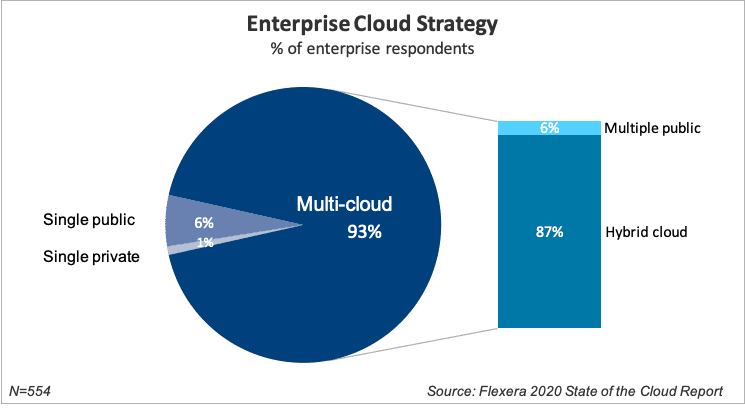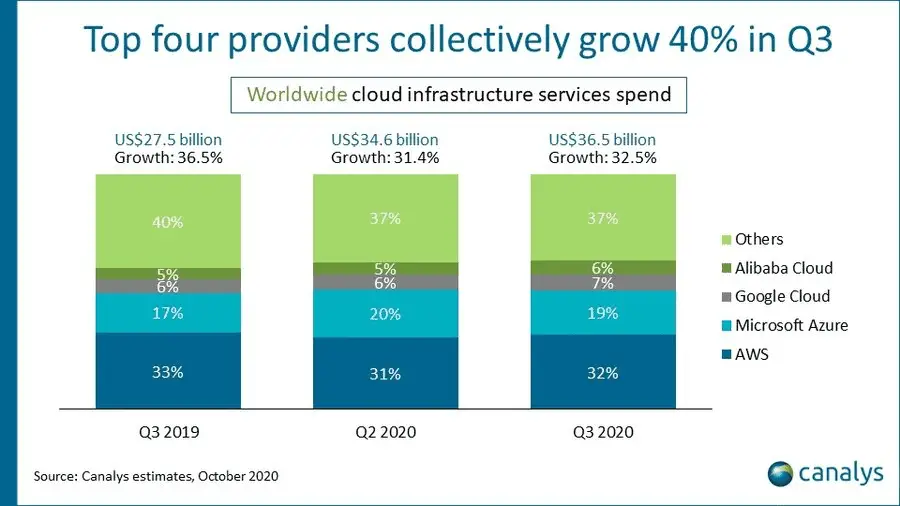
There’s a serious trend currently going on among companies. This trend is Multicloud adoption. According to Gartner, as much as 81% of users utilise more than one Cloud provider, which qualifies them as a Multicloud user. This model brings a lot of advantages to businesses, and so more and more decide to switch to multiple providers. According to the State of the Cloud 2020 report, 93% of enterprises responded that they consider their strategy to be Multicloud. Such numbers undoubtedly make one think — what is it about this technology that appeals so much to firms? In this article, you’ll find the answer.
What is Multicloud?
Since Cloud migration is quickly becoming an inevitable step in digital transformation, companies want to maximise the benefits of using it. One of the methods of doing that is Multicloud.
It consists of utilising multiple providers on the same network to take advantage of their strong points.
While these methods serve largely the same purpose, the main difference between hybrid Cloud and Multicloud is the fact that the former involves using both public and private platforms, while the latter consists of using two or more different providers.
How to adopt Multicloud?
Migrating to Multicloud is certainly not an easy process. It takes a lot of planning and a thorough strategy. You’ll have to consider a lot of points to make sure that it’s a profitable move. First of all, make sure that your current infrastructure is ready to migrate. The two essential things to consider are your APIs, and the automation. Optimising these for Multicloud is a crucial step.
Another thing to do is the comparison of different providers. If you choose a combination, ensure that your employees are familiar with the platform. Provide necessary training and onboarding.
Centralised management of your system is critical as well. This involves switching from Command Line Interface processes to Software-Driven Networking, which are two different environments. It will require you to change up your operations so as to fit the new methodology.
The unification of your current infrastructure matters as well. This simplifies the management later on by reducing protocol diversity.
Current market state
At this point in time, AWS is the uncontested leader of the Cloud market.
With 32% of the revenue in their pockets, Amazon has quite the edge over the competition. This is largely due to Amazon’s headstart in the Cloud industry. They were the first to provide such services.
The runner-up is Microsoft with Azure Cloud. While Azure has a long distance to cover, they’ve been steadily growing during the past few years. This is mostly because of their shift of focus to Azure instead of Windows. Microsoft is making an effort to make Azure its main selling point. The fact that Windows is such an abundant system with a lot of corresponding, perfectly optimised software, makes Azure more than a considerable contestant for AWS.
Other significant players are Google with 7% share and Alibaba with 6%. Still, Alibaba Cloud is a popular solution almost exclusively in China.
Another thing worth mentioning here is the collaboration of Oracle and Microsoft to make their Cloud services even better. This makes for an excellent Multicloud adoption opportunity.
The benefits of Multicloud
Multicloud, even though the migration is quite complicated, brings tremendous benefits to users.
Better reliability
Since you combine two or more platforms’ resources, you get better reliability and reduced disruption of services. If one provider fails (this happens sometimes), there are others to back them up. The possibility of disruptions is greatly reduced, as simultaneous downtime across multiple platforms is far less likely.
Price reduction
Seeing that different providers have different strengths and advantages to their platform, you get to choose only the ones that specialise in the area you need. Going with Multicloud allows you to optimise the package according to your business needs. You can choose to go with the providers whose specific features are the cheapest to cut your costs.
Quicker response time
Latency is something that can’t yet be avoided completely. While technology such as edge computing allows you to reduce it, it’s still there. The same goes for Multicloud — similarly to edge computing, it enables you to reduce the response time to a great degree. Seeing that Multicloud uses the resources of multiple providers, you get more locations to utilise.
More independence
Going with Multicloud reduces the dependence on a single provider. This saves you from vendor lock-in, which can prove to reduce flexibility. Applications that can function across multiple platforms protects you from restricting your possibilities.
Taking advantage of strengths
Using only the features a particular provider specialises in allows you to optimise the performance of your systems. Seeing that suppliers allow you to only use specific features, you could base your departments on multiple platforms. You have more resources you can use up as well, making scalability easier.
Disadvantages of Multicloud
While Multicloud may seem like the perfect solution for all of your problems, it does pose some challenges.
One of the primary things to consider is the fact that you take the benefits of using a single provider out of the picture. Since you decide to commit to different platforms, you don’t get any bonuses, as most policies prevent you from getting them if you use other suppliers.
Another concern is security. While multiple platforms give you the benefit of different security measures, it becomes increasingly difficult with each new provider to devise an infrastructure. This is due to the fact that the platforms differ from one another, and creating a security system across multiple platforms is more complex.
Management is quite a bit harder as well. Tracking and monitoring more than one environment requires knowledge of each of them.
Lastly, as I’ve noted before, migration can prove to be extremely difficult to conduct. It requires a lot of preparation, time, skill, and resources.
Wrap-up
I believe that the benefits outweigh the disadvantages significantly. As such, it’s not a perfect solution and there are some things you’ll need to consider before deciding on whether you want to adopt Multicloud.
